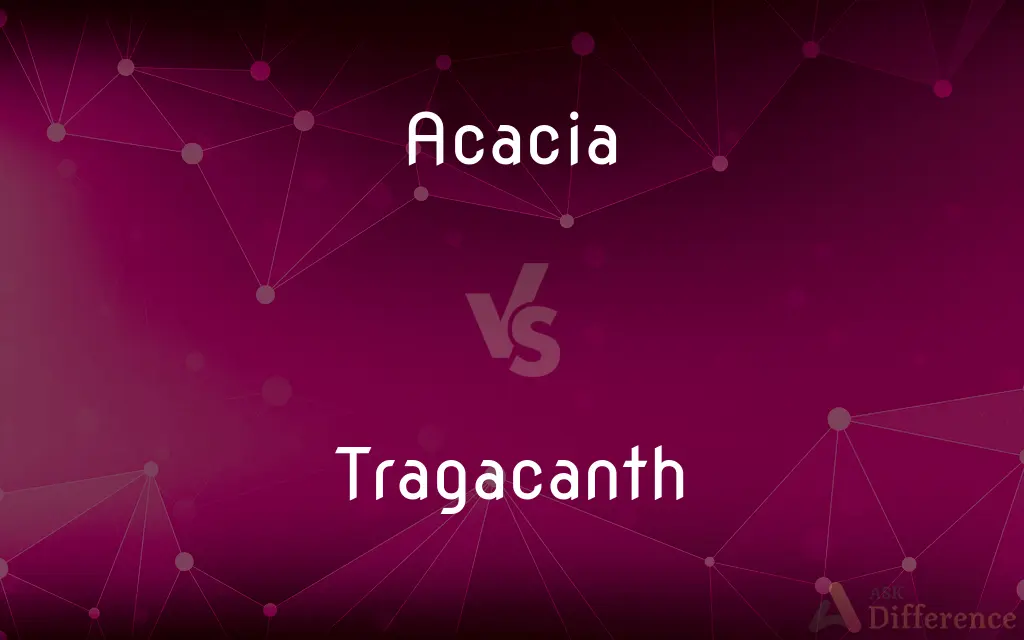Acacia vs. Tragacanth — What's the Difference?
By Tayyaba Rehman & Maham Liaqat — Updated on April 24, 2024
Acacia is a genus of shrubs and trees known for their gum, used as a food additive and in pharmaceuticals, whereas tragacanth is a gum derived from Astragalus species, used similarly but noted for its superior viscosity and stability.

Difference Between Acacia and Tragacanth
Table of Contents
ADVERTISEMENT
Key Differences
Acacia trees and shrubs are predominantly found in tropical and subtropical regions, producing a gum used primarily as a food additive and stabilizer. Whereas, tragacanth gum comes from the dried sap of Astragalus plants, which grow mainly in the Middle East and parts of Asia.
Acacia gum, also known as gum arabic, is harvested by making incisions in the bark of the tree. On the other hand, tragacanth gum is obtained through similar methods but is sourced from different species within the genus Astragalus, known for their ability to produce a particularly viscous gum.
In terms of chemical composition, acacia gum is primarily a complex mixture of glycoproteins and polysaccharides, making it an excellent emulsifier. Whereas tragacanth gum contains a higher proportion of complex polysaccharides, giving it even better thickening, emulsifying, and stabilizing properties.
Acacia gum is widely used in the food industry, especially in candies, soft drinks, and inks. Whereas tragacanth gum is more frequently used in pharmaceuticals, cosmetics, and textile industries due to its superior thickening and stabilizing abilities.
Both gums are considered safe for consumption and have similar uses as dietary fibers and laxatives. However, tragacanth gum is often preferred in applications where a stronger adhesive quality or a higher viscosity is required.
ADVERTISEMENT
Comparison Chart
Botanical Source
Acacia species
Astragalus species
Primary Use
Food additive, stabilizer
Thicker, stabilizer in pharma and cosmetics
Method of Extraction
Incisions in the tree bark
Incisions in plant stems
Chemical Composition
Glycoproteins, polysaccharides
Mainly complex polysaccharides
Notable Properties
Emulsifying, stabilizing
High viscosity, superior stabilizing
Compare with Definitions
Acacia
Found in warm climates.
Acacias thrive in the subtropical regions of Australia.
Tragacanth
A gum from Astragalus plants.
Tragacanth gum is harvested from several species of Astragalus.
Acacia
A genus of shrubs and trees.
The acacia tree in our backyard blooms beautifully in the spring.
Tragacanth
Used as a stabilizer and thickener.
The viscous nature of tragacanth makes it ideal for cosmetic products.
Acacia
Known for gum arabic production.
Acacia gum is widely used in the food industry as an emulsifier.
Tragacanth
Valued in pharmaceuticals.
Due to its properties, tragacanth is preferred in drug formulations.
Acacia
Used in both food and industry.
Besides food, acacia gum is also used in pharmaceuticals.
Tragacanth
Primarily found in the Middle East.
Tragacanth sourcing is common in the mountainous regions of Iran.
Acacia
Produces yellow or white flowers.
The white blossoms of the acacia were a highlight of our nature walk.
Tragacanth
Known for its superior viscosity.
Tragacanth's viscosity surpasses that of many other natural gums.
Acacia
Acacia, commonly known as the wattles or acacias, is a large genus of shrubs and trees in the subfamily Mimosoideae of the pea family Fabaceae. Initially, it comprised a group of plant species native to Africa and Australasia, but it has now been limited to contain only the Australasian species.
Tragacanth
Tragacanth is a natural gum obtained from the dried sap of several species of Middle Eastern legumes of the genus Astragalus, including A. adscendens, A. gummifer, A. brachycalyx, and A. tragacantha. Some of these species are known collectively under the common names "goat's thorn" and "locoweed".
Acacia
Any of various often spiny trees or shrubs of the genus Acacia in the pea family, having alternate, bipinnately compound leaves or leaves represented by flattened leafstalks and heads or spikes of small flowers.
Tragacanth
Any of several spiny Asian shrubs of the genus Astragalus of the pea family, especially A. gummifer, of the Middle East, yielding a gum used in pharmaceuticals, adhesives, and textile printing, and as an emulsifier and thickener in foods.
Acacia
Any of several other plants in the pea family, especially of the genus Robinia.
Tragacanth
The gum of any of these plants.
Acacia
See gum arabic.
Tragacanth
A polysaccharide gum, extracted from several species of leguminous plants of the genus Astragalus, formerly used medicinally and now as a food additive. Also more fully gum tragacanth.
Acacia
(countable) A shrub or tree of the tribe Acacieae.
Tragacanth
A kind of gum procured from a spiny leguminous shrub (Astragalus gummifer) of Western Asia, and other species of Astragalus. It comes in hard whitish or yellowish flakes or filaments, and is nearly insoluble in water, but slowly swells into a mucilaginous mass, which is used as a substitute for gum arabic in medicine and the arts. Called also gum tragacanth.
Acacia
The thickened or dried juice of several species in Acacieae, in particular Vachellia nilotica (syn. Acacia nilotica), the Egyptian acacia.
Tragacanth
A gum used in pharmacy, adhesives, and textile printing
Acacia
A false acacia; robinia tree, Robinia pseudoacacia.
Acacia
(uncountable) Gum arabic; gum acacia.
Acacia
(loosely) Any of several related trees, such as the locust tree.
Acacia
A light to moderate greenish yellow with a hint of red.E3D733
Acacia
A roll or bag, filled with dust, borne by Byzantine emperors, as a memento of mortality. It is represented on medals.
Acacia
A roll or bag, filled with dust, borne by Byzantine emperors, as a memento of mortality. It is represented on medals.
Acacia
A genus of leguminous trees and shrubs. Nearly 300 species are Australian or Polynesian, and have terete or vertically compressed leaf stalks, instead of the bipinnate leaves of the much fewer species of America, Africa, etc. Very few are found in temperate climates.
Acacia
The inspissated juice of several species of acacia; - called also gum acacia, and gum arabic.
Acacia
Any of various spiny trees or shrubs of the genus Acacia
Common Curiosities
What is acacia commonly used for?
Acacia is commonly used as a food additive, known as gum arabic, and in pharmaceutical applications.
How is tragacanth gum extracted?
Tragacanth gum is extracted by making incisions in the stems of Astragalus plants and collecting the dried sap.
What makes tragacanth gum different from acacia gum?
Tragacanth gum has higher viscosity and stability, making it suitable for more demanding applications like pharmaceuticals and cosmetics.
Can both acacia and tragacanth be used in food?
Yes, both are used in food for their emulsifying, stabilizing, and thickening properties.
Are there any dietary benefits to consuming these gums?
Both gums act as dietary fibers and can help with digestion and regularity.
How sustainable is the harvesting of these gums?
Harvesting is generally sustainable, but it depends on specific practices and regional regulations.
What are the visual characteristics of acacia flowers?
Acacia typically produces bright yellow or white fluffy flowers.
Are acacia and tragacanth gums expensive?
The cost can vary, but tragacanth gum is typically more expensive due to its superior properties and lesser availability.
What are the environmental conditions favorable for acacia growth?
Acacia trees thrive in warm, subtropical climates.
Is there a reason to choose tragacanth over acacia in manufacturing?
Tragacanth is often chosen over acacia in applications that require stronger adhesion and greater thickening properties.
Can these gums cause allergies?
While generally safe, some individuals may experience allergic reactions to natural gums.
Which industries primarily use tragacanth gum?
The pharmaceutical, cosmetic, and textile industries primarily use tragacanth gum.
What regulatory standards apply to these gums?
Both gums are regulated for purity and safety, especially when used in food and pharmaceutical products.
Do acacia and tragacanth have any medicinal properties?
Yes, both are used in traditional medicine for their soothing and healing properties.
Is tragacanth gum easy to process?
Tragacanth gum requires careful processing to maintain its high-quality thickening properties.
Share Your Discovery

Previous Comparison
Annoy vs. Spite
Next Comparison
Pliers vs. TongsAuthor Spotlight
Written by
Tayyaba RehmanTayyaba Rehman is a distinguished writer, currently serving as a primary contributor to askdifference.com. As a researcher in semantics and etymology, Tayyaba's passion for the complexity of languages and their distinctions has found a perfect home on the platform. Tayyaba delves into the intricacies of language, distinguishing between commonly confused words and phrases, thereby providing clarity for readers worldwide.
Co-written by
Maham Liaqat













































